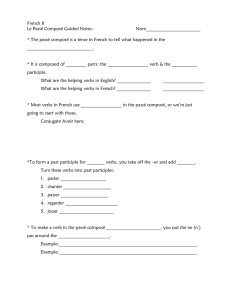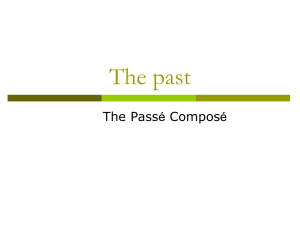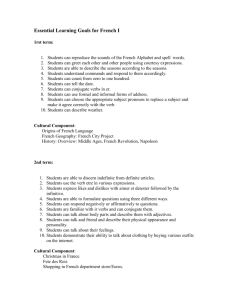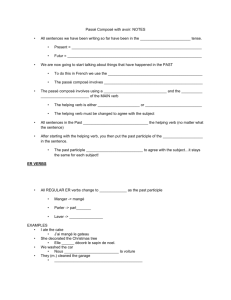INTASC 7 Artifact: Lesson Plan
advertisement
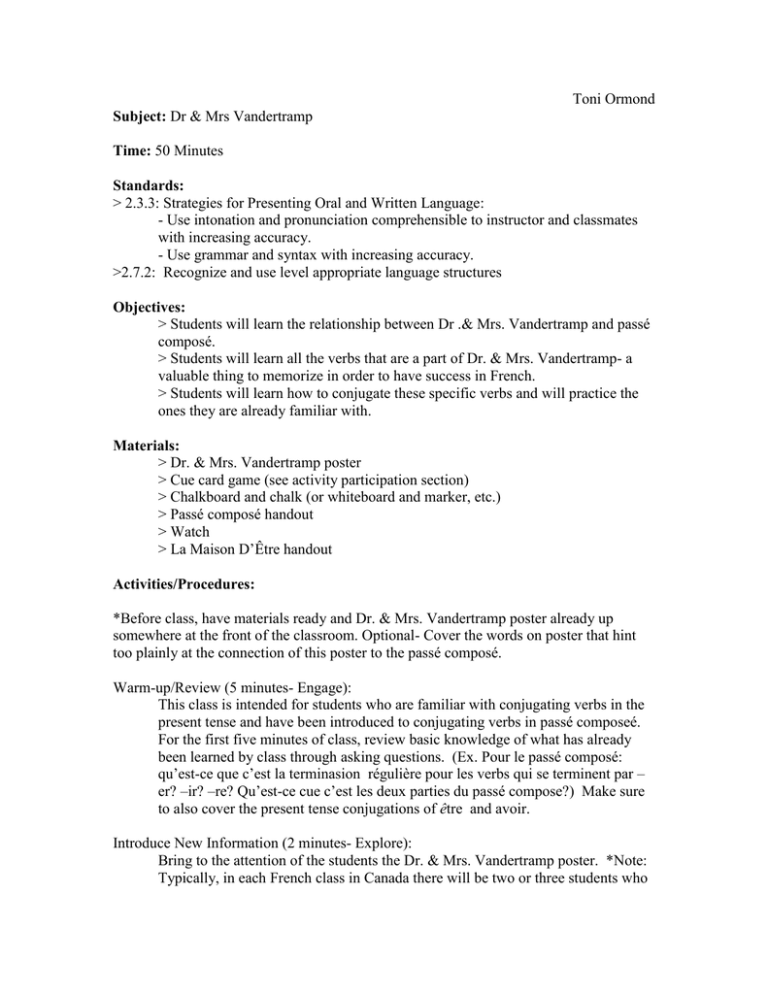
Toni Ormond Subject: Dr & Mrs Vandertramp Time: 50 Minutes Standards: > 2.3.3: Strategies for Presenting Oral and Written Language: - Use intonation and pronunciation comprehensible to instructor and classmates with increasing accuracy. - Use grammar and syntax with increasing accuracy. >2.7.2: Recognize and use level appropriate language structures Objectives: > Students will learn the relationship between Dr .& Mrs. Vandertramp and passé composé. > Students will learn all the verbs that are a part of Dr. & Mrs. Vandertramp- a valuable thing to memorize in order to have success in French. > Students will learn how to conjugate these specific verbs and will practice the ones they are already familiar with. Materials: > Dr. & Mrs. Vandertramp poster > Cue card game (see activity participation section) > Chalkboard and chalk (or whiteboard and marker, etc.) > Passé composé handout > Watch > La Maison D’Être handout Activities/Procedures: *Before class, have materials ready and Dr. & Mrs. Vandertramp poster already up somewhere at the front of the classroom. Optional- Cover the words on poster that hint too plainly at the connection of this poster to the passé composé. Warm-up/Review (5 minutes- Engage): This class is intended for students who are familiar with conjugating verbs in the present tense and have been introduced to conjugating verbs in passé composeé. For the first five minutes of class, review basic knowledge of what has already been learned by class through asking questions. (Ex. Pour le passé composé: qu’est-ce que c’est la terminasion régulière pour les verbs qui se terminent par – er? –ir? –re? Qu’est-ce cue c’est les deux parties du passé compose?) Make sure to also cover the present tense conjugations of être and avoir. Introduce New Information (2 minutes- Explore): Bring to the attention of the students the Dr. & Mrs. Vandertramp poster. *Note: Typically, in each French class in Canada there will be two or three students who are very advanced in the language as it is what they speak at home. Ask students if anyone knows the relationship between these verbs and the passé composé. Allow numerous students to take a guess at what it could be before just blatantly stating the answer. Explanation (10 minutes- Explain): Now it is time to begin the lesson plan on the new information. To start, explain the relationship between Dr. & Mrs. Vandertramp and the passé compose (verbs of movement that are often followed by a preposition). All of the verbs in Dr. & Mrs. Vandertramp need to have an auxiliare of être. Also explain to students that with Dr. & Mrs. Vandertramp, the participe passé must match whether the subject is masculine/feminne (e) and singular/plural (s). After going through each verb with my students to make sure they understand their meanings, I will write down the full conjugations of Devenir, Monter, and Descendre on the chalkboard as those verbs are both regular and similar to many of the other verbs included in Dr. & Mrs. Vandertramp. (Je suis devenu(e), Tu es devenu(e), Il/Elle est devenu(e), Nous sommes devenu(e)s, Vous êtes devenu(e)s, Ils/Elles sont devenu(e)s…) Partner-Problem Solving (10 minutes- Elaborate): At this point, I will have my students work in pairs to finish conjugating all the Dr. & Mrs. Vandertramp verbs in their notebooks. After five minutes of this, I will ask one member of each pair to come to the board and conjugate one verb with all the subjects. Afterwards the student in the pair who did not write the verb on the board will read out the verb conjugations for the class. After each student reads, I will ask the class if there is anything that needs to be corrected. This will help students practice writing in French and also speaking in French. Active Participation (10 minutes- Engage): This activity is intended to reach out to the students who learn better through actions and interactive games. To begin, hand two cue cards to each student. One side of the card will have the word “action” on it with a verb, and the other will have “réponse” on it with another verb. The student with the card that has #1 on it will start the game by standing up and acting out the verb on the card. The student who has the card “réponse” with the appropriate verb will then stand up and say “Il/Elle a/est ___________” (passé composé). Once he or she says that phrase, the other student will sit down and the student who said the answer will turn their cue card around and act out the verb that is on the other side of the card. This will continue until the last student acts out a verb and turns around their card to find the word “la fin.” Plan B (addition to the last game): If I have extra time at this point in the lesson, I will mix up the cards and then time my students and challenge them to receive a better time than they did the first time around, forcing them to be more attentive and helping them become quicker at thinking of the correct way to conjugate verbs in this tense. Individual Work (12 minutes- Evaluate): For the final activity, I will have my students work individually on a handout that features sentences that they must fill in with the proper auxiliare and participe passé (the verb will be beside the blank in its regular form before conjugation). During this time I will encourage students to ask me any questions and I can also walk around the class to evaluate who fully grasps the idea and who has not. Clean-up (1 minute): Give studens one minute to gather belongings and be ready to leave by the time the bells rings so they can get to their next class on time. Plan C: If at some point during the class I realize I am ahead of schedule, I can hand out La Maison D’Être to my students and have them fill out the house with the Dr. & Mrs. Vandertramp verbs and also write a sentence in passé composé using each of the verbs featured in the house. This handout would be useful as it is a really popular handout given to students by teachers when students are first being introduced to this concept. Teacher’s Reflection:
